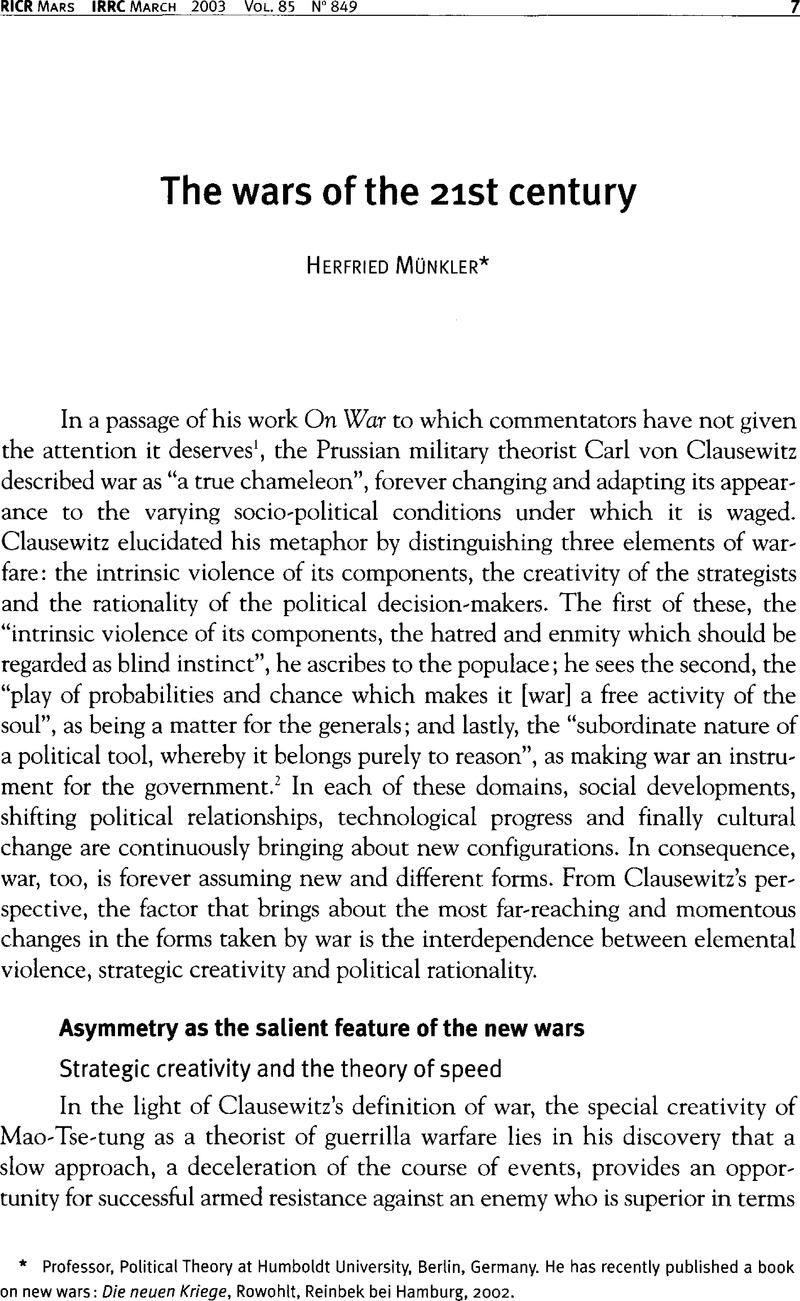No CrossRef data available.
Article contents
The wars of the 21st century
Published online by Cambridge University Press: 25 February 2011
Abstract

- Type
- Research Article
- Information
- International Review of the Red Cross , Volume 85 , Issue 849: Les nouveaux types de conflits/New types of conflicts , March 2003 , pp. 7 - 22
- Copyright
- Copyright © International Committee of the Red Cross 2003
References
1 An exception to this rule is Herberg-Rothe, Andreas, Das Rätsel Clausewitz: Politische Theorie im Widerstreit, Munich, 2001, esp. pp. 98 ff.Google Scholar
2 von Clausewitz, Carl, Vom Kriege, 19th ed., Werner Hahlweg, Bonn, 1980, pp. 212 ff.Google Scholar
3 Of Virilio's extensive works, see especially his essay La vitesse de libération, Paris, 1995.Google Scholar
4 The availability of the atom bomb apart, it is above all the inflated logistical structure of modern armies on which Martin van Creveld, in his much discussed book The Transformation of War, Simon & Schuster Inc., New York, 1991 (published in German under the title, Die Zukunft des Krieges, Munich, 1998Google Scholar), bases his argument that the wars of the future will no longer be waged with conventional armies.
5 For more detail, see Münkler, Herfried, Über den Krieg: Stationer) der Kriegsgeschichte im Spiegel ihrer theoretischen Reflexion, Weilerswist, 2002, pp. 173 ff.Google Scholar
6 Aron, Raymond, Der permanente Krieg, Frankfurt/M., 1953, p. 48.Google Scholar
7 See Münkler, Herfried, Die neuen Kriege, Reinbek bei Hamburg, 2002, p. 175.Google Scholar
8 Klaus-Jürgen Gantzel, for example, has defended the view that, once capitalist society has been adopted on a world scale, war will disappear as a means of acquiring goods and services. Gantzel, Klaus-Jürgen, “Kriegsursachen: Tendenzen und Perspektiven”, Ethik und Sozialwissenschaften, Vol. 3, No. 8, 1997, pp. 257–266.Google Scholar
9 See Parker, Geoffrey, The Military Revolution: Military Innovation and the Rise of the West, 1500–1800, Cambridge University Press, Cambridge, 1988.Google Scholar
10 See Jung, Anne (ed.), Ungeheuerist nurdas Normale: Zur Ökonomie der “neuen” Kriege, medico international, Frankfurt/M., 2002Google Scholar; Berdal, Mats and Malone, David M. (eds), Greed and Grievance: Economic Agendas in Civil Wars, Lynne Rienner Publishers, Boulder/London, 2000Google Scholar; Jean, François and Rufin, Jean-Christophe (eds), Economie des guerres civiles, Paris, 1996.Google Scholar
11 An exhaustive account of old and new forms of so-called suicide attacks is to be found in Reuter, Christoph, Mein Leben ist eine Waffe: Selbstmordattentäter - Psychogramm eines Phänomens, Munich, 2001.Google Scholar
12 See also Münkler, Herfried and Fischer, Karsten, “‘Nothing to kill or die for…’ — Überlegungen zu einer politischen Theorie des Opfers”, in: Leviathan 28, 2000, Vol. 3, pp. 343–362Google Scholar, and Münkler, Herfried, “Terrorismus als Kommunikationsstrategie: Die Botschaft des 11 September”, Internationale Politik 56, 2001, Vol. 12, pp. 11–18.Google Scholar
13 This distinction is discussed in detail by Mary Kaldor in Neue und alte Kriege: Organisierte Gewalt im Zeitalter der Globalisierung, Frankfurt/M., 2000.Google Scholar
14 This question is discussed in greater detail in Herfried Münkler, “Die Kriege der Zukunft und die Zukunft der Staaten” in Wolfgang Knöbl/Gunnar Schmidt (eds), Die Gegenwart des Krieges: Staatliche Gewaltin der Moderne, Frankfurt/M., 2000, pp. 52–71.Google Scholar
15 For example, Eppler, Erhard, Vom Gewaltmonopol zum Gewaltmarkt: Die Privatisierung und Kommerzialisierung der Gewalt, Frankfurt/M., 2002.Google Scholar




